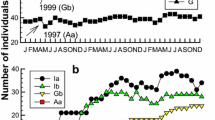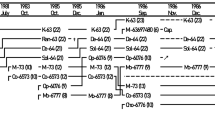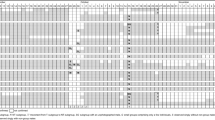Abstract
This is the first report of group fission in a wild group of Moor macaques (Macaca maurus) in South Sulawesi, Indonesia. The subject group, which has been observed on the basis of individual identification since 1988, showed no sign of fission in April 1999. In August 1999, the group had split in two, with the same number of mature females in each new group. For the most part, mothers and their offspring joined the same groups. Dominance relations and association patterns established during the previous year among adult females did not strongly affect new group membership. The difference in female reproductive state between the two branch groups was a prominent characteristic. The α-male of the original group visited both groups at the first stage of group fission, even though otherwise the compositions of the new groups were stable. After the division, six adult males from outside the original group immigrated exclusively into the group that did not contain the α-male of the original group. Severe intergroup encounters occurred between the two groups. We discuss the process of the fission and the resultant pattern in relation to the egalitarian dominance style among females, lack of seasonality in reproduction, and resemblance to one-male type social organization.
Similar content being viewed by others
REFERENCES
Chepko-Sade, B. D., and Sade, D. S. (1979). Patterns of group splitting within matrilineal kinship group: Study of social group structure in Macaca mulatta (Cercopithecidae, Primates). Behav. Ecol. Sociobiol. 5: 67-86.
Cords, M., and Rowell, T. E. (1986). Group fission in blue monkeys of the Kakamega forest, Kenya. Folia Primatol. 46: 70-82.
Dittus, W. P. (1988). Group fission among wild toque macaques as a consequence of female resource competition and environmental stress. Anim. Behav. 36: 1626-1645.
Fooden, J. (1980). Classification and distribution of living macaques. In Lindburg, D. (ed.), The Macaques, Van Nostrand Reinhold, New York, pp. 1-9.
Furuya, Y. (1968). On the fission of troops of Japanese monkeys. I. Five fissions and social chages between 1955 and 1966 in the Gagyusan troop. Primates 9: 323-350.
Furuya, Y. (1969). On the fission of troops of Japanese monkeys. II. General view of troop fission of Japanese monkeys. Primates 10: 47-69.
Hohmann, G. (1989). Group fission in Nilgiri langurs (Presbytis johnii). Int. J. Primatol. 10: 441-454.
Koyama, N. (1970). Changes in dominance rank and division of a wild Japanese monkey troop at Arashiyama. Primates 11: 335-390.
Malik, I., Seth, P. K., and Southwick, C. H. (1985). Group fission in free-ranging rhesus monkeys of Tughlaqabad, Northern India. Int. J. Primatol. 6: 411-422.
Martin, P., and Bateson, P. (1993). Measuring behaviour: An introductory guide (2nd Edition). Cambridge Univ. Press, Cambridge.
Maruhashi,T. (1982). Anecological study of troop fissions of Japanese monkeys (Macaca fuscata yakui) on Yakushima Island, Japan. Primates 23: 317-337.
Maruhashi, T. (1992). Fission, takeover, and extinction of a troop of Japanese monkeys (Macaca fuscata yakui) on Yakushima Island, Japan. In Itoigawa N. et al. (eds.), Topics in Primatology vol. 2. Univ. of Tokyo Press, Tokyo, pp. 47-56.
Matsumura, S. (1998). Relaxed dominance relations among female moor macaques (Macaca maurus) in their natural habitat, South Sulawesi, Indonesia. Folia Primatol. 69: 346-356.
Matsumura, S., and Okamoto, K. (1997). Factors affecting proximity among members of a wild group of moor macaques during feeding, moving, and resting. Int. J. Primatol. 18: 929-940.
Menard, N., and Vallet, D. (1993). Dynamics of fission in a wild Barbary macaque group (Macaca sylvanus). Int. J. Primatol. 14: 479-500.
Nash, L. T. (1976). Troop fission in free-ranging baboons in the Gombe Stream National Park. Am. J. Phys. Anthropol. 44: 63-78.
Oi, T. (1988). Sociological study on the fission of wild Japanese monkeys (Macaca fuscata yakui) on Yakushima Island. Primates 29: 1-19.
Okamoto, K., and Matsumura, S. (in prep.). Intergroup encounters in wild moor macaques (Macaca maurus): A comparison with Japanese macaques (M. fuscata). Primates, submitted.
Okamoto, K., Matsumura, S., and Watanabe, K. (2000). Life history and demography of wild moor macaques (Macaca maurus): Summary of ten years of observations. Am. J. Primatol. 52: 1-11.
Prud'homme, J. (1991). Group fission in a semifree-ranging population of Barbary macaques (Macaca sylvanus). Primates 32: 9-22.
Ron, T. (1996). Who is responsible for fission in a free-ranging troop of baboons? Ethology 102: 128-133.
Sato, S. (1988). Seasonal change of grooming behavior among females and relation of male's behavior. Primate Res. 4: 156. (in Japanese)
Struhsaker, T. T., and Leland, L. (1988). Group fission in red-tail monkeys (Cercopithecus ascanius) in the Kibale forest, Uganda. In Gautier-Hion, A. et al. (eds.), A Primate Radiation: Evolutionary Biology of the African Guenons. Cambridge Univ. Press, Cambridge, pp. 363-388.
Sugiyama, Y. (1960). On the division of a natural troop of Japanese monkeys at Takasakiyama. Primates 2: 109-148.
van Schaik, C. P. (1983). Why are diurnal primates living in groups? Behaviour 87: 120-144.
van Schaik, C. P. (1989). The ecology of social relationships amongst female primates. In Standen, V., and Foley, R. (eds.), Comparative Socioecology: The Behavioural Ecology of Humans and Other Mammals. Blackwell, Oxford, pp. 195-218.
Watanabe, K., and Matsumura, S. (1996). Social organization of moor macaques (Macaca maurus) in the Karaenta Nature Reserve, South Sulawesi, Indonesia. In Shotake, T., and Wada, K. (eds.), Variations in the Asian Macaques, Tokai University Press, Tokyo, pp. 147-162.
Wrangham, R. W. (1980). An ecological model of female-bonded primate groups. Behaviour 75: 262-300.
Yamagiwa, J. (1985). Socio-sexual factors of troop fission in wild Japanese monkeys (Macaca fuscata yakui) on Yakushima Island, Japan. Primates 26: 105-120.
Author information
Authors and Affiliations
Corresponding author
Rights and permissions
About this article
Cite this article
Okamoto, K., Matsumura, S. Group Fission in Moor Macaques (Macaca maurus). International Journal of Primatology 22, 481–493 (2001). https://doi.org/10.1023/A:1010711813637
Issue Date:
DOI: https://doi.org/10.1023/A:1010711813637




